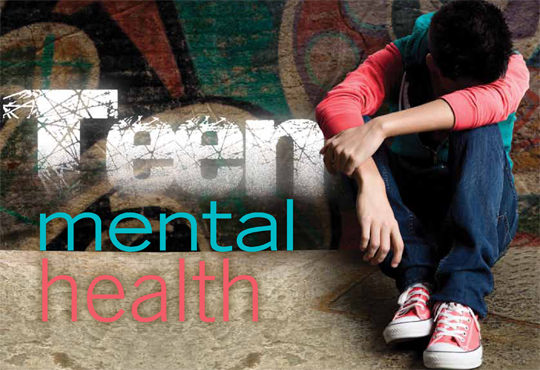
“I was tired of being alone.” …
“I don’t wanna be afraid of myself anymore.” …
“It’s like being churned underneath a giant wave. Spinning. Turning. Flipping with no idea which way the surface is and struggling to breathe all the while.” …
These haunting words are statements made by young people who went on to commit suicide.
Their histories are collated as part of a piercing review of child and youth suicides between 2003 and 2007, conducted by the British Columbia coroners service. The aim, according to the report, was to look for themes and commonalities in the tragic deaths, and what those might teach parents, teachers, health-care professionals and others about warning signs and preventive strategies.
Mental health disorders are misunderstood and stigmatized in society generally; in young people, the line between aberrant behaviour and “normal” teenage misconduct is even more blurred. Kids entering their teens—juggling physical and psychological changes, increased school and family demands, ever-intensifying peer pressure—tend to do what teens have likely been doing for millennia: they push back, they act out, they clam up.
That’s one of the problems of recognizing and treating mental health problems in this age group. “They’re not the easiest group to treat. They’re smart-alecky, they talk back, they are often not very open: to come in and talk to a stranger about their inner thoughts and feelings is pretty foreign to most of them,” says Kelowna psychiatrist Dr. Paul Latimer.
Mental health problems in youth are not uncommon: the BC Ministry of Children and Family Development estimates the rate of mental disorders in children and youth at 15 per cent. That means roughly one in seven young people are dealing with one or more issues ranging from panic attacks, depression and attention-deficit/hyperactivity disorder (ADHD), to schizophrenia, bipolar disorder and psychosis. At the far end of the line, and every parent’s worst nightmare, is suicide. Relatively rare—roughly 15 children and adolescents commit suicide in BC each year—suicide is still the second most common cause of death for youth age 12-18.
While ADHD is typically diagnosed in younger children, the most common mental health problems that manifest as kids hit their teenage years are anxiety and depression, according to Dr. Edward Taylor, director of UBC Okanagan’s school of social work. Both, he says, are frequently seen hand-in-hand with what is considered a mental health disorder in and of itself: substance abuse.
Mental Health and Substance Abuse
“If a preteen is starting on a path of depression, in today’s world where legal and illegal drugs are being introduced on a constant basis, it’s very easy for someone to fall into substance abuse, and the same is true for anxiety,” says Taylor. With either one “constantly blocking and controlling your life, it becomes very easy to start covering that up with some kind of substance.”
Candice Henriques, program director for mental health and addiction services in the Okangan’s ARC program has some cold hard numbers on the entwined nature of mental health problems and substance use. Between Sept. 1, 2009, and Aug. 31, 2010, 196 youth accessed ARC’s school-based substance-use/addiction services program: 184 used marijuana, 178 used alcohol, 86 used ecstasy, 28 prescription drugs, and 27 cocaine (with many kids reporting use of more than one substance). Of the 196, 47 reported having depression, 44 ADHD, 25 an anxiety disorder and 31 self-harming behaviour.
In Latimer’s practice, it’s the ubiquity of pot that poses the most problems for teens also struggling with their mental health. “It’s just a cultural norm now; everybody smokes it. It’s amazing,” he says. According to one of the longest running surveys in Canada, in Ontario, more than one in four school-age students had used marijuana in the last year, a number that rose to 46 per cent among grade 12 students; 12 per cent said they used pot on a daily basis.
If kids have an underlying mental health condition, says Latimer, those are going to be amplified and complicated by regular marijuana use. When he sees teenagers in his practice, convincing them that pot is harming, not helping, their anxiety, depression, panic attacks, hyperactivity, or social disorders is one of his toughest battles. “What I tell them is that it will sometimes make them care less, or feel more mellow, but it’s not helping their underlying problem.”
And Latimer says he just can’t help kids move forward if they’re not willing to quit. “I tell them the facts, I tell them the door is always open, I try not to be judgmental, but I say: I can’t treat you if you continue to do this.”
What’s Normal, What’s Not
For parents, watching their loving and compliant kids turn into moody, argumentative teenagers who experiment with alcohol or drugs is almost a rite of parenthood.
The problem, says Taylor, who has done extensive research in this area, is understanding what’s normal, and what’s not.
He directs parents to a website called Here to Help (www.heretohelp.bc.ca), that provides advice for family members trying to cope with a child (or other family member) with mental health problems. The website offers parents a tip sheet of “concerning behaviours” including a significant drop in grades, a palpable decrease in enjoyment of things the youth previously enjoyed, skipping school, changes in energy level and sleeping patterns, feelings of hopelessness, anxiety, aggression or disobedience,” among others.
A list like that, Taylor agrees, “can scare the hell out of parents” to whom all of these might seem commonplace in their teenaged kids.
“Children have ups and downs,” he points out. “I tell people to look at mental health the same way you do any other health situation.” If your teenager spikes a fever, you wait and see what happens rather than rush to the emergency room. But if a sore ankle is still causing a limp after two weeks, it’s worth a visit to the doctor.
The Kelowna branch of the Canadian Mental Health Association, in collaboration with the BC Ministry for Children and Family Development has published a comprehensive guide to help parents and other grown-ups understand what’s normal, and what isn’t, across different “categories” of mental illness, and what resources are available, locally, for parents and youth seeking diagnosis or care.
Trust Your Intuition
Keli Anderson knows first-hand the kind of second-guessing that can ensnare a parent worried about changes they see in a child. She first sought psychiatric help for her son when he was five years old, but only managed to get the attention of specialists when he became suicidal at age nine. He was ultimately diagnosed with bipolar disorder and hospitalized for seven weeks, but not until he’d spent eight months on the waiting list. Hard as that was, she says, so too was the uncertainty and self-doubt she felt when she first became concerned about his behaviour.
“There is tremendous stigma, embarrassment and self-blame,” she says, “and blame directed at other people who treat you as if (your child’s behaviour) is a result of your parenting. Often people won’t seek help because they’re ashamed, and they end up losing out on valuable information and valuable time that would have helped their child.”
Both Taylor and Anderson advise parents to trust their intuition: “I didn’t get put off by people who told me I was being overprotective,” says Anderson. “I listened to my instincts and I knew that something wasn’t right, and it wasn’t until I reached out to another parent who totally got my story that I thought, OK, finally, I have someone who can identify. It’s very, very lonely, and it’s a really hard thing to know, is it him? Is it me? Is this normal?”
Anderson’s experience prompted her to found the Families Organized for Recognition and Care Equality (FORCE) Society for Kid’s Mental Health to raise support and awareness for child and youth mental health. Now in its eleventh year, the FORCE society helps connect families who are dealing with young people with mental health disorders. After lobbying the BC government to create a plan for child and youth mental health services, FORCE ultimately launched the first Child and Youth Mental Health Day in BC in 2007. The group has succeeded in getting the day recognized nationally and for the first time this year, events were held in Kelowna and other cities across Canada on May 7.
Help for Families
Across all of the mental health problems commonly diagnosed in children and teens, family support is a linchpin of healing and prevention. Latimer says that while he’s started seeing kids who’ve come of their own accord to his walk-in clinic, the majority come to him via a parent or family member.
The ARC program serving the North, Central and South Okanagan also provides a number of specific programs geared towards augmenting or leveraging family support, including family-based treatment for kids with autism spectrum disorder, fetal alcohol spectrum disorder and other developmental-behavioural disorders. Families who are referred via the Ministry of Children and Family Development’s child and youth mental health can then have an ARC counsellor meet with the youth and his or her family, in their own home.
“That way the family is able to build capacity for how to deal with the mental health issues, and can be a part of the change and healing process,” Henriques says. “The parents can learn some skills and strategies for understanding their child’s needs and for the youth, it’s low-barrier. It creates that comfort level, they are more likely to talk to you. You can get a picture of what’s going on, what the dynamic is like, right away, because there is not that sterile office environment.”
Street Kids
Youth without support at home or living on the street, are a tougher problem, particularly if they can’t access the mental health services provided through the school system.
Latimer tells the story of a teenaged boy with a complex mix of mental health problems who came into his walk-in clinic of his own accord. “Here’s someone who is homeless, has no education, no family support, who’s living on the street, with no social assistance. So you start there, by getting him on social assistance and helping him access available resources, find a place to live. Then you can talk to him about stopping smoking pot and lining him up with a doctor and counsellor. But only once you get those basic things done can you start to address the depression and substance use.”
The boy, now in his late teens, has continued to come in for help and has enrolled again in a school program. The starting point, says Latimer, is to make a plan and “to give them hope.”
But in fact, he says, that’s the same message he tries to convey to all of his patients. “I tell them: ‘It may seem like you have all these problems, but these are all solvable, and this is what we’re going to do.’” —Shelley Wood
Editor’s Note:
More than a decade has passed since I was a parent facing the same struggle as Keli Anderson and I am saddened to learn that little appears to have changed in that time. Despite the help of a caring and receptive family doctor over the course of many months, it took my teen’s attempted suicide to get any real action from the agencies charged with youth mental health care. It was the most anguished, frustrating and terrifying period of my life. No child or parent should have to go through what we did to get help.
So I was truly disheartened to receive this message from writer Shelley Wood, the quintessential professional journalist, when she submitted the copy. “This is one of the hardest stories I’ve ever done for you.… Not only was the subject matter hard, of course, but I’ve been really blocked by lots of folks who you’d think would bend over backwards to get this topic some better publicity. Both the school district, and the child and youth mental health department, locally, have stonewalled and directed me towards their ‘media spokespeople’ who have proven next-to-useless.”
I welcome feedback from anyone who has experience with the issue of teen mental health. Send your comments to me at
editorial@okanaganlife.com.



